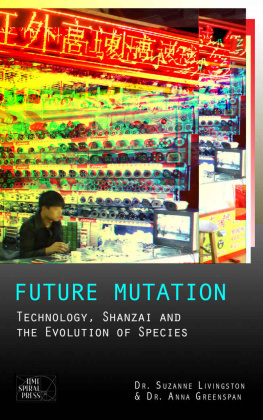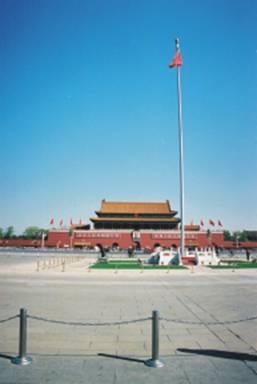Anna Greenspan - Future Mutation: Technology, Shanzai and the Evolution of Species
Here you can read online Anna Greenspan - Future Mutation: Technology, Shanzai and the Evolution of Species full text of the book (entire story) in english for free. Download pdf and epub, get meaning, cover and reviews about this ebook. year: 2015, publisher: Time Spiral Press, genre: Romance novel. Description of the work, (preface) as well as reviews are available. Best literature library LitArk.com created for fans of good reading and offers a wide selection of genres:
Romance novel
Science fiction
Adventure
Detective
Science
History
Home and family
Prose
Art
Politics
Computer
Non-fiction
Religion
Business
Children
Humor
Choose a favorite category and find really read worthwhile books. Enjoy immersion in the world of imagination, feel the emotions of the characters or learn something new for yourself, make an fascinating discovery.
- Book:Future Mutation: Technology, Shanzai and the Evolution of Species
- Author:
- Publisher:Time Spiral Press
- Genre:
- Year:2015
- Rating:4 / 5
- Favourites:Add to favourites
- Your mark:
- 80
- 1
- 2
- 3
- 4
- 5
Future Mutation: Technology, Shanzai and the Evolution of Species: summary, description and annotation
We offer to read an annotation, description, summary or preface (depends on what the author of the book "Future Mutation: Technology, Shanzai and the Evolution of Species" wrote himself). If you haven't found the necessary information about the book — write in the comments, we will try to find it.
Anna Greenspan: author's other books
Who wrote Future Mutation: Technology, Shanzai and the Evolution of Species? Find out the surname, the name of the author of the book and a list of all author's works by series.
Future Mutation: Technology, Shanzai and the Evolution of Species — read online for free the complete book (whole text) full work
Below is the text of the book, divided by pages. System saving the place of the last page read, allows you to conveniently read the book "Future Mutation: Technology, Shanzai and the Evolution of Species" online for free, without having to search again every time where you left off. Put a bookmark, and you can go to the page where you finished reading at any time.
Font size:
Interval:
Bookmark:
"You cannot stop what cant be stopped, you cannot touch without being touched."
- Nick Land
"Technology obeys no-ones will. Can we play along with it without laboring to master it? "
- John Gray
Copy
New technologies build themselves through a conglomeration of parts from all around the world; the design teams of Silicon Valley, the raw material from the mines of Africa, the capital markets fuelled by the Middle East. Shenzhen is the gathering place; a central node in the circulatory system. This is where the body of global electronics is assembled and shipped out.
The market condenses in an area known as Huaqiangbei . Wide crowded streets are illuminated by strips of neon and LED, which are plastered over cheap looking malls with their blue tinted glass and gray, drab concrete. The monotony of the urban landscape is all-too-familiar to anyone accustomed to the new pop-up cities of China. Peering inside the windows, however, one gets a taste of the intensity of all that is clustered inside. Building after building, floor upon floor, stall upon stall, shelf upon shelf, is dedicated to the buying, selling, and building of electronics. Everywhere are mountains of wires, mounds of chips, spools of lights, cases of buttons and nobs. Huaqiangbei Shenzhen is high tech toolbox to the world.
The citys population is almost all the same age. This is a town of workers, not a place for the young or the old. Employees stand behind signs advertising companies of whom few have ever heard: Victory Star Electronics, First Semiconductors, Gimi Technologies. Each has carved out its own tiny, individual space designed especially to host a particular species of micro-commercial activity. Despite the fame of factory giants like Foxconn, the dizzying scale of electronic production in Shenzhen is not all united in any single operation. Instead, the magnitude arises from a multiplication effect; an enormous amassing of many small parts.
Some of the tech on show is cutting edge (one booth proudly displays a touch screen 3D TV), but most is more mundane. One mall is stuffed with wiring and routers. Inside another, thousands of surveillance cameras all watch themselves in an unrelenting display of machinic vision. The most colorful mall is devoted entirely to cell phone accessories. Myriad stores contain rows of identical plastic kitties, bears or bunnies, which are sold to add personality to the intrinsic standardization of the device.
Upstairs, where the buildings are darker and emptier, in a zone reserved for packaging, the secrets of Huaqiangbei are revealed. Two workers form a chain, one folding cardboard retail boxes, another sticking labels: iPhone 4; Samsung Galaxy, the precious guarantee of branding stripped of all mystique by the cool indifference of the clone. The most popular item to emerge from the markets of Shenzhen is the copy-cat cellphone. This is where you come to find a Motopola, a Nikia or even a fake Xiaomi (which is the copy of a clone). Though some counterfeits try to disguise the fact that they are fakes many are more open and playful. Shenzhen is the birth-place of shanzhai , the zone in which copying which is both inherent to digital technology and a critical part of the cultural traditions of China have fused with the production of electronics.
Shanzhai traces its roots back to 2004, when the Taiwanese company MediaTeK released a multipurpose chip that made mobile phones cheap and easy to produce. A wave of small factories, many of them family owned, immediately seized the opportunity to feed an already ravenous market for counterfeits and began pumping out copies at a delirious speed. Shanzhai companies operate in a nebulous, quasi legal zone external to both corporate regulations as well as government rules. The name shanzhai means mountain village and the term signals a kind of bandit, anarchist mode of production that functions outside the formal legitimacy of either capitalism or the state. Today there are hundreds of millions of shanzhai phones in circulation, not only in China but throughout Asia, Africa, Latin America and the Middle East, where some argue it was the glut of cheap cell phones that helped enable the Arab Spring. [1] This knockoff technology has spread to the most remote corners of the planet. Even in the hermit kingdom of North Korea the trade in shanzhai goods is said to be robust. Inside China the practices of shanzhai have spread far beyond cell-phones. The irreverent copy-cat quick, flexible and close to the street has come to define a culture that is anarchic, entrepreneurial and increasingly operates at the cutting edge of high tech.
Reproduce
One of the most profoundly relevant texts on the issues raised by contemporary technology was written nearly one hundred and fifty years ago. In 1872 the author Samuel Butler travelled to the then remote colony of New Zealand. Inspired by his journey, Butler wrote the novel Erewhon . In this long ago voyage to a place far removed from civilization ('erewhon' is an anagram for nowhere), he perceived the first stirrings of a new species alien and unknown which was evolving from the intimate interminglings of human and machine.
Erewhon is set in a wild and sparsely inhabited place. It tells the tale of an early settler named Higgs who is driven to explore an uncharted land. Warned and then abandoned by his native guides, Higgs makes his way alone over a steep mountain pass. There, on the far end of the island, he encounters the Erewhonians, an unknown civilization with odd customs and curious beliefs.
One of the most striking anomalies of this fictional race is their complete even fanatical renunciation of all machines. As soon as he arrives in this faraway land, Higgs own wristwatch is dramatically confiscated. The only other machinery he sees during his time immersed in this alien culture is broken, unused and safely encased inside a museum. Higgs finds this especially strange, since it is clear from the historical records that hundreds of years previously Erewhonian society had reached a most advanced degree of technological sophistication. The basis for this mystifying behavior, Higgs eventually discovers, can be traced back centuries to arguments posed in a philosophical tome, known as The Book of the Machines a fictional text within a text that is kept guarded within the libraries of Erewhon .
'The Book of the Machines' begins with a time travel scenario, imagining intelligent creatures returning to the deep past when our planet was nothing but a hot round ball. No one could have dreamt from this embryonic state that life would one day sprout on Earth. Yet, Butler speculates, just as human consciousness emerged from dark matter, is it not possible that a new phase of mind could still arise that is as different from all present known phases, as the mind of animals is from that of vegetables? It would be rash, he warns, to say that no others can be developed, and that animal life is the end of all things...[2] In doing so, he maps out a scenario that has never been more relevant that technology may, as a result of its own driving forces, be transforming us as a species, stretching our senses, reformatting our brains, giving us new organs controlled from afar, altering all that is most intimately human.
'The Book of the Machines' advances its most far-reaching and radical arguments in wrestling with the possibility of technologys drive to reproduce itself. It is said by some, contends the author, that machines can never be developed into animate or quasi-animate existences, in as much as they have no reproductive system, nor seem ever likely to possess one. Yet, just because machines do not marry, or that we are never likely to see a fertile union between vapour engines with the young ones playing about the door of the shed it does not mean that the potential for reproduction is closed. We can already observe an enormous diversity in the reproductive systems of existing life forms. Why, argues Butler, should this mutiplicitous variation come to an end? After all no one expects that all the features of the now existing organisations will be absolutely repeated in an entirely new class of life. The reproductive system of animals differs widely from that of plants, but both are reproductive systems. What would make us presume that this ongoing process has now, suddenly, come to an end? Surely nature, as Butler wrote, has not exhausted her phases of this power?[3]
Next pageFont size:
Interval:
Bookmark:
Similar books «Future Mutation: Technology, Shanzai and the Evolution of Species»
Look at similar books to Future Mutation: Technology, Shanzai and the Evolution of Species. We have selected literature similar in name and meaning in the hope of providing readers with more options to find new, interesting, not yet read works.
Discussion, reviews of the book Future Mutation: Technology, Shanzai and the Evolution of Species and just readers' own opinions. Leave your comments, write what you think about the work, its meaning or the main characters. Specify what exactly you liked and what you didn't like, and why you think so.












